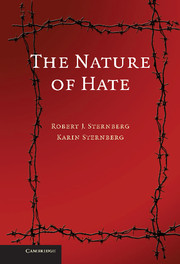Book contents
- Frontmatter
- Contents
- Preface
- 1 The Problem: The Role of Hate in the World
- 2 Definitions and Theories of Hate
- 3 The Duplex Theory of Hate I: The Triangular Theory of the Structure of Hate
- 4 The Duplex Theory of Hate II: A Story-Based Theory of the Development of Hate
- 5 Interpersonal Relationships – Love–Hate
- 6 The Role of Propaganda in Instigating Hate
- 7 Application of the Duplex Theory of Hate to Massacres, Genocide, and Terrorism
- 8 Are There Any Cures for Hate?
- Appendix: Triangular Hate Scale
- References
- Author Index
- Subject Index
- Figure Credits
4 - The Duplex Theory of Hate II: A Story-Based Theory of the Development of Hate
Published online by Cambridge University Press: 05 June 2012
- Frontmatter
- Contents
- Preface
- 1 The Problem: The Role of Hate in the World
- 2 Definitions and Theories of Hate
- 3 The Duplex Theory of Hate I: The Triangular Theory of the Structure of Hate
- 4 The Duplex Theory of Hate II: A Story-Based Theory of the Development of Hate
- 5 Interpersonal Relationships – Love–Hate
- 6 The Role of Propaganda in Instigating Hate
- 7 Application of the Duplex Theory of Hate to Massacres, Genocide, and Terrorism
- 8 Are There Any Cures for Hate?
- Appendix: Triangular Hate Scale
- References
- Author Index
- Subject Index
- Figure Credits
Summary
Hate arises from stories. The story portion of the theory of hate must be understood in its relation to stories of love. Hence, we discuss stories of love first, in order to contrast them later with stories of hate.
The stories of hate are obviously not the same as the stories of love. So why would one want to understand stories of love to understand stories of hate? The reason emanates from considerations discussed in the last chapter. Stories of love can and sometimes do transform themselves into stories of hate. The opposite is less likely to happen. For example, one may have a story of love toward one's romantic partner. But this story may give way to a story of hate if one's story of love is transformed into a story of hate by a perception of betrayal, as when one finds one's partner in bed with someone else, or when one finds that things one has always believed about one's partner turn out to have been the result of an intentional deception on the part of a partner.
Oddly, it is important to understand the relation of love and hate as well because stories of hate can give way to stories of love. Romeo and Juliet is a story of rival families that hate each other. Nevertheless, a member of each family comes to love a member of the opposing family. West Side Story, Leonard Bernstein's most favorite musical, picks up on this theme.
- Type
- Chapter
- Information
- The Nature of Hate , pp. 78 - 109Publisher: Cambridge University PressPrint publication year: 2008



